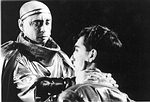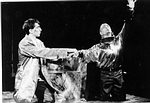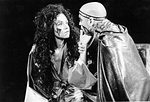BOOK P/REVIEWS
Michael Elliot Rutenberg, Oedipus of Lucius Annaeus Seneca
Wauconda, Illinois, Bolchazy-Carducci Publishers: 1998
ISBN 0865164630 (hardbound), 0865164592 (paper)
103 pages, with Introduction, 2 appendices, and 5 photographs
Reviewed by Thomas D. Kohn
University of Mississippi
The front cover and the title-page proclaim that Michael Rutenberg's version of Seneca's Oedipus has been "freely translated and adapted". This might be the proper place to point out that any translation is by necessity an adaptation. It is impossible to transform perfectly a work from one language to another, especially when going from an inflected language, with flexible word order, into one where word placement is more important for primary meaning. But Rutenberg's version is, in fact, an adaptation, different from the literal and ubiquitous translation of F.J. Miller,[1] and even a far cry from the free verse rendition which Ted Hughes originally created for Sir John Gielgud and the National Theatre Company.[2] Rutenberg's Oedipus is based on a number of assumptions.
Rutenberg assumes that Seneca's choral passages are extraneous to the action of the play, mere embolima, to use Aristotle's terminology.[3] Rutenberg states in his Introduction that "[u]nfortunately, these lyric arias tend to hold up the action" (page 14). Thus, he replaces the Chorus of Thebans with one man, named "Chorus," who comments on the action directly to the audience and quotes liberally from the letters and dialogues of Seneca the Philosopher. For the curious, Rutenberg provides the sources for his Chorus in Appendix I, and he also includes "modernized" versions of Miller's translations of the original choral passages in Appendix II.
Rutenberg also assumes that Sophocles' Oedipus Tyrannus is the direct source for Seneca's play, and so has "restored parts of scenes left out of Seneca's version, but which are present in the original source" (page 17). Rutenberg has Jocasta re-enter following Creon's report of the necromancy (Act 3, page 59), defending her brother as she does at OT 634-48. Rutenberg has Tiresias come back after the extispicium in order to confront Oedipus (Act 3, pages 61-4), in a scene adapted from OT 316-462. And in the end, Creon returns to take custody of Oedipus, his children, and his throne (Act 5, pages 90-2), as he does at OT 1416-1523.
Further, Rutenberg assumes that a modern audience is not as familiar with Greek myths as Seneca's would have been. Thus, Rutenberg eliminates most of Seneca's allusions, and fills in several vital details from the Oedipus story. For example, he includes the text of and answer to the riddle of the Sphinx (Act 1, page 38). And he copies Sophocles' account (OT 774-812) of the events which drove Oedipus to flee from Corinth to Delphi and then to Thebes (Act 4, page 70).
Finally, Rutenberg alters a great deal of the staging. Instead of having Oedipus enter alone at the start of the play, he is accompanied by Jocasta. Instead of performing the extispicium on-stage, he has Manto report it as if it had previously happened.[4] And in the end, Oedipus is escorted by Creon and Jocasta is carried off-stage (page 92), before a final word from Chorus.
A scholar could argue with some of Rutenberg's choices. One could say that Seneca's choral passages are, in fact, linked to the themes and symbolism of the play. One could state that Oedipus is the central character of Seneca's drama, and so the Roman playwright keeps the roles of all the other characters to a minimum. One could maintain that Oedipus' isolation is a key thematic element, and so he needs to be alone when he enters at the beginning and when he exits at the end. The frequent allusions and the omission of key details, one could point out, are both distinctive features of Seneca's style. And one could suggest that Rutenberg has left out much by glossing over Senecan wordplay. Consider, for example, line 81 of the original Latin, when Oedipus, considering flight, speaks the word parentes, immediately before his wife and unbeknownst mother interrupts, thus providing much irony for a knowing audience.
In short, a scholar could find much to criticize in this adaptation, if Rutenberg had intended to produce a faithful translation for academic purposes. But this is not the case. The fundamental assumption of this work is that it is a script, meant for performance in front of a modern audience. Rutenberg did not make his alterations on a whim, as his "rather long introduction" (page 29) makes clear. His prefatory remarks, which at times read like a fine set of program notes, are a well-reasoned discussion both of his additions and omissions and of the value of Senecan tragedy to a modern audience.
The script itself is very readable, and I can imagine it fitting onto a modern stage quite well. The language is fairly straightforward, yet the suggestion of Senecan syntax remains. The stage directions are derived from a hypothetical performance, and not from the actual production Rutenberg directed at Hunter College, as the costume suggestions do not match the production photographs interspersed throughout the text. But the production photos, both the ones found in the book and those appended below, along with the testimonial quotes on the back cover of the paper edition, give an indication as to the power and effectiveness of Rutenberg's adaptation. If you desire a faithful translation of Seneca's Oedipus, this book is not the one to choose. But if you want a retelling of the Oedipus myth which aims to resonate with a modern audience, and which takes Seneca's tragedy as a starting point with extra material from Sophocles and Seneca the Philosopher, Rutenberg has created just the thing.
 |
 |
 |
 |
Click on individual image to see larger versions.
